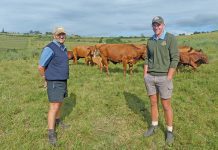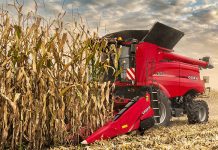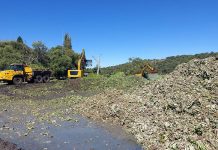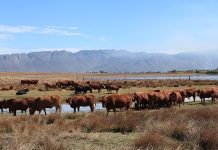Brahmans, first developed in the US during the 1800s when Zebu cattle were crossed with mainly British breeds, have today revolutionised commercial cattle herds in tropical, subtropical, dry and extensive areas in particularly the southern hemisphere. The Brahman’s genetic versatility, adaptability to conditions, hybrid vigour, longevity, disease resistance, heat tolerance, good maternal abilities, ease of calving and utilisation of low-quality grazing, have made it a popular breed in SA. T his year marks the South African Brahman Breeders’ Society’s 50th anniversary, with the breed first brought to SA in the 1950s by a number of colourful personalities, including Miles Dicke’s grandfather the late John Warren, who was also an avid Afrikaner breeder.
John was born in Stutterheim but started farming in Limpopo at Gravelotte in 1941. He first noticed Brahman advertisements in Farmer’s Weekly in the 1950s and was so impressed with the Florida-based Norris Cattle Company’s (NCC) animals that he imported a bull. he type NCC Sir 135, the son of the famous Imparanso 200/0, was soon on a six-week journey to Durban where the bull faced a 90-day quarantine. Eventually, the by-now overweight American Brahman bull was on its 18-hour journey north in a modified Volkswagen Combi – arriving on Gravelotte in June 1956. On the journey the bull spent its time bellowing longingly at the attractive cows along the road. In Limpopo the bull was crossed with different types of cattle and outperformed other cattle in the area. However, neighbours were sceptical about the long ears and hump. John eventually gave bulls to his neighbours to increase Brahman numbers. Then in 1962 he imported cows to expand his herd to 150 cows. Unable to capture the old Florida type after 20 years of breeding, new genetics were introduced such as Nelore, Indu Brazil and Guzerat. Peter Warren, John’s son, continued with Warren Brahmans after John retired. is today an honorary life member of the South African Brahman Breeders’ Society. In 1969 John’s son-in-law, Theo Dicke – a former student of Prof Jan Bonsma – armed with his first three cows from the Warren herd, began building the well-known Dicke Brahman Stud in Duiwelskloof in Limpopo.
Extensive international travelling by Theo and deep involvement in the South African Brahman Breeders’ Society has seen Dicke Brahmans become one of the most respected studs in SA. Miles gets involved oday it consists of 500 stud cows run in the subtropical Lowveld by Theo and on the temperate and sour coastal plains of the Eastern Cape by his son Miles. Land was first bought in the Cape in the mid-1980s and later in the 1990s to take Dicke Brahmans to the sour coastal plains near Kei Mouth. Meanwhile, Miles completed a B.Agric degree in the mid-1990s before heading to the US and South America to work and to see the biggest Brahman ranges in the world. In 1999 he returned to Dicke Brahmans in Kei Mouth. “Brahmans have put everybody through school,” Miles says. “Brahmans have made us who we are.
My grandfather and father were brilliant cattlemen. What they have forgotten about Brahmans I must still learn.” The importance of crossbreeding Apart from his 100 stud cows, Miles runs 400 commercial cows, exploiting the Brahman’s ability to produce quality crossbred cows. “A very big part of our farming integration is commercial crossbred cattle,” Miles says, and adds that the value of the Brahman (of the Bos indicus species) lies in its genetic ability to complement and add value to any other breed through crossbreeding. “Crossbreeding Brahman bulls with continental and British breeds of the Bos taurus species produces adaptable, fertile, and good mothers that produce exceptionally fast-growing weaners,” he says.
This ability of crossbreeding capabilities has contributed to a number of breeds – Santa Gertrudis, Simbra, Braford, Beefmaster, Brangus, Charbray, Droughtmaster and Brahmousin. In fact, the Brahman is a crossbreed between Indian Zebu cattle and Bos taurus breeds. “It crossbreeds well with anything,” Miles says. Miles’ stud and commercial cattle are managed similarly, except for mating. Depending on where the herd is located and specific conditions, Miles employs seasonal mating with bulls running with the females from 1 November until February – he also has a winter mating season. With the stud, bulls are left with the cows permanently in single-sire herds, while in the commercial herd a multi-sire approach is used with heifers mated at 20 to 24 months. Why supplementing adds value On the sourveld near Kei Mouth, Miles has found that to get the best calving percentages, weaning weights and ICPs, supplementation is vital. Both herds are supplemented for 200 days a year on a homemade lick and receive Multimin and vitamin injections three times a year.
“I am a farmer and I add value. There’s a difference between farming and ranching. I farm and supplement my cattle to the best of my ability to ensure the best beef production,” he says. Miles admits there is a fine line between the balance of what is supplemented to the cow and what she produces while on sourveld. “If I did not supplement, I would look at a 60% calving percentage,” Miles says. A target of 400 days ICP and a 92% calving percentage is Miles’ goal for his stud herd – currently it averages an ICP of 415 to 420 days, and an 89% calving percentage. He believes this can be improved through clever supplementation, and despite the R250 to R300 invested per cow per year, the extra-heavy seven-month-old weaners make economic sense – specifically regarding Brahman-type cows’ ability to still produce at 15 to 18 years.
For 90 days bulls are rounded off for sale, aided by 12ha of maize on the farm. The role of the stud With his 100 stud cows he aims to produce quality Brahman genetics that emphasise the development of economic features, such as more kilograms per hectare without losing the intrinsic value of the Brahman’s adaptability and fertility. His stud therefore not only produces bulls for his commercial herd, but also 20 quality bulls for commercial farmers – sold at multi-breed bull sales in the Eastern Cape and KZN. Miles buys in genetics from around SA, and bulls are swapped between the two Dicke herds in the south and north. Every year Miles identifies breeders in certain parts of SA and visits them to share ideas. It’s on these trips that bulls are often identified and bought to improve the next generation of cows.
“If you’re not improving your females every year, you’re wasting your time,” he says. With the foundation of established genetics, Miles has focused on breeding hardy, functional, fertile females that will reproduce unattended in extensive conditions, while bulls are selected for muscularity, mobility and very short clean sheaths able to function in extreme conditions and environments. Miles emphasises the importance of herd sires. “Your decisions regarding your stud sires affect the entire chain of events from stud cattle right through to your commercial cattle. We farm beef cattle to earn a living and the cows have to produce. Breeding should be market-driven. We must chase functionality and economics,”
Miles advises. He aims to produce the best commercial Brahman bulls. “I will rather sell 20 bulls for R10 000 than one bull for R200 000. We want to offer the best commercial bulls on the market,” he says, adding that they hear what their clients want while at the sales. “The guy that pays for the bull is important. He defines whether you are doing the job correctly,” Miles says. This year, bulls sold at Queenstown, Elliot and Cedarville, achieved the highest averages for Brahmans at all three sales, and one was recognised as the best bull at the Bathurst sale. Contact Miles Dicke on 084 589 3174.








